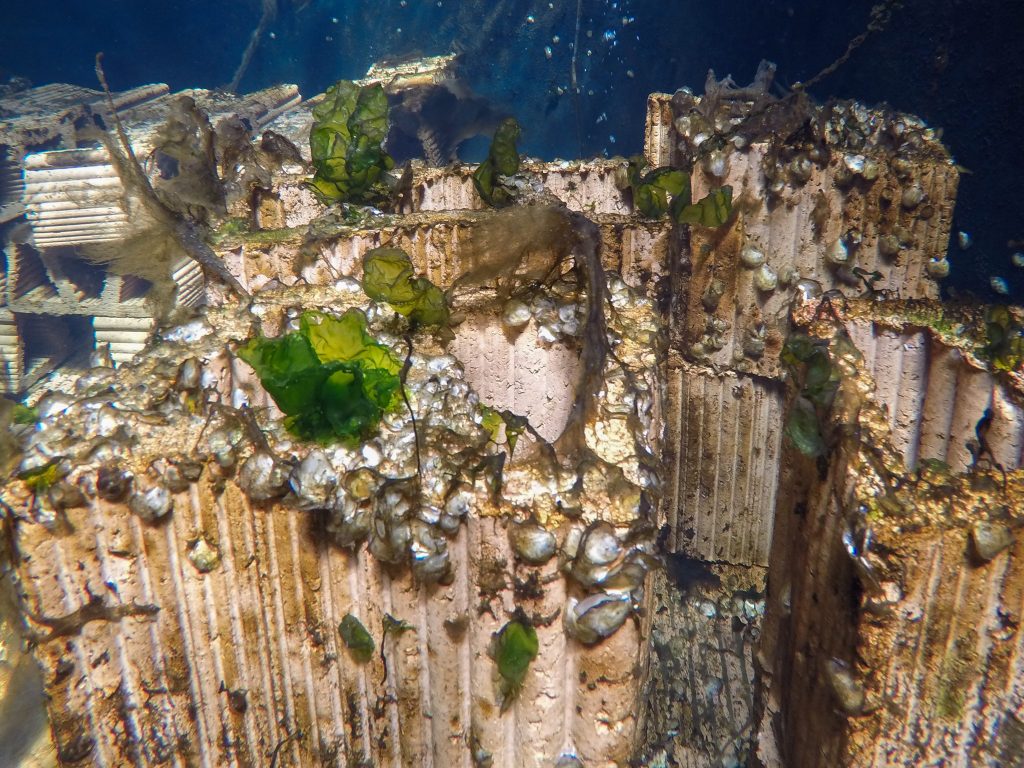Nestle Purina Petcare Europe has invested in a conservation startup that aims to generate voluntary marine biodiversity credits from a pilot by creating oyster reefs off the UK coast.
Netherlands-based Oyster Heaven could not reveal the exact amount of the investment but said it received more than €1 million ($1.1 mln) towards its mission to boost underwater life while also generating nutrient credits .
“We convinced one of the largest food and beverage companies in the world to partner with us in developing an ecosystem service offering from our pilot reefs,” said George Bircher, founder and business leader of Oyster Heaven .
“The company is committed to the project to understand the ecosystem benefits that the reef can generate, with the aim of expanding it significantly across the North Sea if all goes well,” Bircher told Carbon Pulse. Reefs are formed from piles of live and dead oyster shells.
Purina has also invested undisclosed sums in three other marine habitat restoration initiatives in Europe as part of its Ocean Restoration Program, it announced Wednesday.
Together, Purina’s investments aim to help four initiatives to restore 1,500 hectares of aquatic environments by 2030, in France, the Netherlands, Norway, Portugal, Germany, and the UK, Purina said in a press release release.
Dutch seagrass meadow-planting enterprise Sea Ranger Service, Norwegian excess sea urchin removal company Urchinomics, and Portuguese seaweed restorer SeaForester are also included in the program.
HOW TO MAKE AN OYSTER REEF
Oyster populations have declined by approximately 85% worldwide, making them one of the most severely affected marine species on the planet, according to a report published by The Nature Conservancy in 2009.
Hague-based Oyster Heaven aims to use their ability to filter water, provide food for other species, and protect coastlines.
The company aims to create oyster reefs by placing them in biodegradable clay structures, with about 100 oysters per square meter, before dropping them into the sea. About 1,200 square meters of clay ‘bricks’, each chunk weighing about 6 kilograms, are needed to cover a 5-ha area.

Clay bricks before entering the sea. All images source: Oyster Heaven
The bricks are on pallets from a factory before being placed in tanks, where oyster larvae can live in them for several weeks.
Members of the local community dropped the bricks on boats into the ocean. In fact, the model depends on cooperation with fishing groups, Bircher said.
“They lead the projects, they put it in the water, they get paid a day rate to deploy these reefs, we’ll train them in monitoring and maintenance. And they’ll get more crabs and lobsters to fish for.”
“What we don’t want to happen is to further squeeze the fishing communities, because they are not having a good time. Yields are down, fuel prices are up, and licenses are more expensive.”
Oyster Heaven can license its commercial activity from the Crown Estate, which owns the seabed up to around 12 miles off the UK coast.
BABY OYSTERS
Voluntary biodiversity credits, nutrient credits, and biodiversity net gain units offer a “huge” window of profit for oyster reefs, without having to eat the oysters, Bircher said.
The regulations made it “easy” to convince clients about the need to prepare for more biodiversity requirements. Bircher could not reveal whether anyone other than Purina has said they will invest in Oyster Heaven, but said he hopes to share commitments soon.
“Whether you’re in the UK, the Netherlands, or the US, there are different flavors of the same type of regulation.” The company is initially focused on the UK but is considering projects in oceans around the world.
Voluntary biodiversity credits produced by oyster reefs will use a method developed by the non-profit Wallacea Trust to measure the increase in nature.
The Wallacea Trust defines the credit as a 1% increase, or avoidance of loss, in biodiversity per hectare using a location-dependent ‘basket of metrics’. The Biodiversity Futures Initiative (BFI) should independently assess claims made using the Wallacea framework.
Oyster Heaven selected credit metrics for its pilot including fish abundance and reef surface roughness. It will collect indicators for five years to allow the baby oysters time to grow before breeding.
The videos taken by the divers hope to see more cod, eels, herring, crabs, and lobsters. The company works with Newcastle University and the Netherlands Institute of Oceanographic Research on data collection, leasing it to an independent third party.

Underwater clay reef full of young oysters
Purina intends to keep the credits themselves to boost their own biodiversity credibility, rather than sell them, according to Bircher.
Another potential source of revenue from future projects for Oyster Heaven could be the creation of off-site marine net gain (MNG) units under upcoming UK legislation, Bircher said.
The government is pushing MNG proposals for requiring developers to leave the marine environment in a better state than before any activity took place.
The MNG law follows the implementation of the mandatory biodiversity net gain requirement for developers this month. “If you want to have any kind of development in water, whether it’s offshore wind [farms]cabling, or a new bridge, you will need to offset the damage to biodiversity,” Bircher said.
NUTRIENT CREDITS
Oyster Heaven hopes to generate nutrient credits to help nearby developers comply with nitrogen impact requirements. A nutrient credit represents 1 kg of nitrogen or phosphate, usually mitigated through practices such as stopping agricultural activities, under English regulations.
“Generally all our reefs are aimed at being within 500 m of shore. We think that one hectare of oyster reef filters about 500 kg of nitrogen a year. At £2,500 to £3,000 per 1 kg, that’s £1.5 million worth of nitrogen credits per hectare of oyster reef over its lifetime,” estimates Bircher.
Nutrient credits are expensive because they are pegged to expensive English farmland, but Oyster Heaven aims to reduce market prices.
“Right now, the only way to generate nitrogen credits is by closing a local pig or dairy farm. But unless you reduce the demand for bacon or milk, a new farm will pop up somewhere else – the problem is just move,” Bircher said.
In addition, it takes about 35 years on average for nitrogen to reach the water from the source, so the area would not benefit from reduced nutrient leakage from a farm for this period, he said.
There should be demand for Oyster Heaven’s nutrient credits from developers in coastal counties running the scheme, such as Hampshire, if it gets regulator approval.
“Oysters cannot participate in this regulated system, but Natural England has given us a communication saying it is possible if we provide the right burden of evidence.”
Oyster Heaven will use underwater benthic chambers to measure the amount of nitrogen filtered from seawater by oysters, with measurements taken every two years.
LONG TERM PLAN
The company, linked to the prolific reproduction rate of oysters, sees reefs covering thousands of hectares under the most ambitious future.
Starting with just five acres, Oyster Heaven plans to drop enough clay oyster reefs to cover an area of about 150 within five years.
“I hope your 150 acres will quickly become tens of thousands of hectares. Each mother oyster will have 57,000 offspring over the course of her lifetime – perhaps 10% of whom survive to reproductive adults.”
If the company helps embed 100 million oysters in the ocean by 2027, they could filter 20 billion liters of water a day, managing 200 tons of sewage annually, Oyster’s website says Heaven.
Although oysters are monocultural, 100 mln would not be too much for marine ecosystems, Bircher said. “We will not reach the point where we have a lot of oysters. We are bringing back the same oysters that were there 150 years ago.
There are no plans yet to farm oysters – but the company will consider sustainable harvesting if numbers boom in 20 years, he said.
Through various revenue streams, Oyster Heaven seeks to demonstrate how private corporations can capitalize on natural capital, making conservation less dependent on philanthropy and government grants in an effort to bridge the biodiversity financing gap.
By Thomas Cox – [email protected]
*** Click here to sign up to our twice-weekly biodiversity newsletter ***


